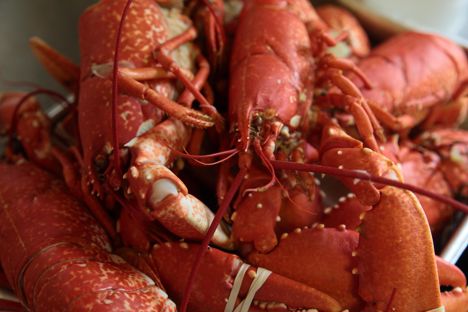Lobster is a luxurious delicacy definitely worth shelling out for! Though plentiful in British waters and available all year round, it is still considered a special treat and the ultimate in fine dining – though Lobster and chips is increasingly finding its way on to gastro pub menus.
The European lobster found in the cold waters of England, Scotland and Ireland (often referred to as a Native lobster) is considered the best quality with the Canadian or American lobster being a cheaper, more plentiful option.
What to look for when buying live lobster
If you buy a live lobster, you can be assured of its freshness but it means killing it yourself and many home cooks don’t relish that task. If you’re willing to do the deed, pick one that smells sea-fresh and curls its tail back under its body when stretched. Ensure the claws are bound or you could get a very nasty nip. Live lobsters aren’t pink like cooked ones but a dark blue-green colour.
Keep live lobsters in the fridge wrapped in a damp cloth and always cook on the day of purchase.
How to prepare lobster
The kindest way to dispatch a live lobster is to use a sturdy, sharp knife and push the tip firmly and quickly through the centre of the cross on its head, making sure the blade side is directed towards the tail – this should kill it instantly. Many consider dropping a live lobster into boiling water cruel – even if it has been rendered unconscious in the freezer.
How to cook lobster
Once killed, lobsters are normally boiled. A whole lobster (approx. 500g) should take about 4 minutes to cook.
Alternatively, grilling a lobster on a hot grill or barbecue can take about 8–10 minutes. Once cooked, the shell of a lobster will turn a vivid red and the juices that seep from the shells will start to coagulate.
After cooking, leave to cool before pulling off the claws in order to crack them and remove the luscious white meat. Pull off the tail and peel as if it were a large prawn.
If you are feeling brave, lobster is also delicious served raw as carpaccio. Simply blanch in boiling water for 30 seconds then plunge into iced water. This will enable you to remove the shell without actually cooking the lobster. Peel the lobster, slice finely and serve with fresh flavours such as lemon, ginger and spring onion.
What lobster goes with
To aficionados, the sweet, mild taste of succulent lobster flesh needs very kittle enhancing. Keep it simple: serve lobster hot with melted butter like Bryan Webb or cold with lemon mayonnaise. If you don’t want to detract from the hero of the dish serve with a tossed green salad, chips, boiled or baked potatoes, grilled corn on the cob and fresh bread rolls.
The subtle taste of pasta complements lobster brilliantly. Ravioli or tortellini stuffed with lobster mousse like Kevin Mangeolles' Lobster tortellini, roast chicken wings and sweetcorn purée or tagliatelle smothered in a lobster cream is delicious.
Lobster Thermidor is a bit different – this classic dish is creamy and cheesy with hot mustard overtones so it needs something light and fresh on the side; raw fennel, green beans and sugar snap peas dressed in garlic are all good options.
Get in touch
Please sign in or register to send a comment to Great British Chefs.



